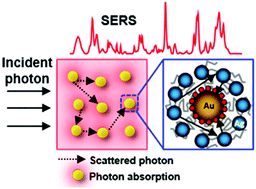Scattering-mediated absorption from heterogeneous nanoparticle assemblies in diblock copolymer micelles for SERS enhancement†
Abstract
Plasmonic superstructures composed of multiple metal nanoparticles (NPs) may represent an elegant example for hot-spot mediated surface-enhanced Raman scattering (SERS) enhancement. For sufficient SERS activity in the superstructures, the gap distance between adjacent NPs has to be engineered to be as small as possible, and often a sub-5 nm gap distance is necessary to create intensive hot spots. However, despite the recent advances in synthesis, the preparation of such plasmonic superstructures still requires laborious assembly, purification, and separation steps. In addition, the resulting plasmonic assemblies often undergo agglomeration and conformational change, which deteriorates the uniformity of the gap distance as well as SERS reproducibility. To overcome these issues, we utilized the self-segregating behavior of block copolymer micelles, and concomitantly functionalized the core and corona of micelles with different kinds of metal NPs. The prepared micellar NP assemblies structurally resembled colloidal core–satellite NP assemblies and exhibited strong SERS activity. However, unlike the initial expectation, the plasmonic coupling between dissimilar NPs was blocked in the micellar structure. Alternatively, we discovered that the local field inside the micellar NP assembly could be enormously amplified by multiple scattering processes, which significantly increased the path length of incident photons for SERS enhancement.



 Please wait while we load your content...
Please wait while we load your content...